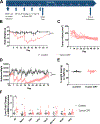Associative learning contributes to the persistence of fatigue-like behavior in male mice in a model of cancer survivorship
- PMID: 36323360
- PMCID: PMC10208403
- DOI: 10.1016/j.bbi.2022.10.018
Associative learning contributes to the persistence of fatigue-like behavior in male mice in a model of cancer survivorship
Abstract
Persistent fatigue is a debilitating side effect that impacts a significant proportion of cancer survivors for which there is not yet an FDA-approved treatment. While certainly a multi-factorial problem, persistent fatigue could be due, in part, to associations learned during treatment. Therefore, we sought to investigate the role of associative learning in the persistence of fatigue using a preclinical model of cancer survivorship. For this purpose, we used a murine model of human papilloma virus-related head and neck cancer paired with a curative regimen of cisplatin-based chemoradiation in male C57BL/6J mice. Fatigue-like behavior was assessed by measuring variations in voluntary wheel running using a longitudinal design. Treatment robustly decreased voluntary wheel running, and this effect persisted for more than a month posttreatment. However, when wheels were removed during treatment, to minimize treatment-related fatigue, mice showed a more rapid return to baseline running levels. We confirmed that the delayed recovery observed in mice with continual wheel access was not due to increased treatment-related toxicity, in fact running attenuated cisplatin-induced kidney toxicity. Finally, we demonstrated that re-exposure to a treatment-related olfactory cue acutely re-instated fatigue. These data provide the first demonstration that associative processes can modulate the persistence of cancer-related fatigue-like behavior.
Keywords: Associative learning; Cancer; Chemoradiation; Conditioned responses; Fatigue; Survivorship.
Copyright © 2022 Elsevier Inc. All rights reserved.
Conflict of interest statement
Declaration of Competing Interest The authors declare that they have no known competing financial interests or personal relationships that could have appeared to influence the work reported in this paper.
Figures




Similar articles
-
The fatigue-inducing effects of cancer and its therapy are characterized by decreased physical activity in the absence of any motivational deficit.Brain Behav Immun. 2024 Mar;117:205-214. doi: 10.1016/j.bbi.2024.01.014. Epub 2024 Jan 18. Brain Behav Immun. 2024. PMID: 38244945 Free PMC article.
-
Sex differences in the behavioral and immune responses of mice to tumor growth and cancer therapy.Brain Behav Immun. 2021 Nov;98:161-172. doi: 10.1016/j.bbi.2021.08.225. Epub 2021 Aug 19. Brain Behav Immun. 2021. PMID: 34418499 Free PMC article.
-
Interplay between Learning and Voluntary Wheel Running in Male C57BL/6NCrl Mice.Int J Mol Sci. 2023 Feb 21;24(5):4259. doi: 10.3390/ijms24054259. Int J Mol Sci. 2023. PMID: 36901690 Free PMC article.
-
Protective effect of HMG CoA reductase inhibitors against running wheel activity induced fatigue, anxiety like behavior, oxidative stress and mitochondrial dysfunction in mice.Pharmacol Rep. 2012;64(6):1326-36. doi: 10.1016/s1734-1140(12)70930-1. Pharmacol Rep. 2012. PMID: 23406743
-
Seven days of muscle re-loading and voluntary wheel running following hindlimb suspension in mice restores running performance, muscle morphology and metrics of fatigue but not muscle strength.J Muscle Res Cell Motil. 2010 Aug;31(2):141-53. doi: 10.1007/s10974-010-9218-5. Epub 2010 Jul 15. J Muscle Res Cell Motil. 2010. PMID: 20632203
Cited by
-
The metabolic basis of cancer-related fatigue.Neurosci Biobehav Rev. 2025 Feb;169:106035. doi: 10.1016/j.neubiorev.2025.106035. Epub 2025 Jan 30. Neurosci Biobehav Rev. 2025. PMID: 39892436 Review.
-
The fatigue-inducing effects of cancer and its therapy are characterized by decreased physical activity in the absence of any motivational deficit.Brain Behav Immun. 2024 Mar;117:205-214. doi: 10.1016/j.bbi.2024.01.014. Epub 2024 Jan 18. Brain Behav Immun. 2024. PMID: 38244945 Free PMC article.
-
Cancer neuroscience in head and neck: interactions, modulation, and therapeutic strategies.Mol Cancer. 2025 Mar 31;24(1):101. doi: 10.1186/s12943-025-02299-6. Mol Cancer. 2025. PMID: 40165230 Free PMC article. Review.
-
Comprehensive review of mouse models for studying cancer-related fatigue: Methods, findings and future directions (Review).Exp Ther Med. 2025 Jul 21;30(3):178. doi: 10.3892/etm.2025.12928. eCollection 2025 Sep. Exp Ther Med. 2025. PMID: 40746448 Free PMC article. Review.
References
-
- Ader R, 1989. Conditioned immune responses and pharmacotherapy. Arthritis & Rheumatism: Official Journal of the American College of Rheumatology 2, A58–A64. - PubMed
-
- Ader R, Cohen N, Bovbjerg D, 1982. Conditioned suppression of humoral immunity in the rat. Journal of comparative and physiological psychology 96, 517–521. - PubMed
-
- Bower JE, Ganz PA, Desmond KA, Rowland JH, Meyerowitz BE, Belin TR, 2000. Fatigue in breast cancer survivors: occurrence, correlates, and impact on quality of life. Journal of clinical oncology : official journal of the American Society of Clinical Oncology 18, 743–753. - PubMed
Publication types
MeSH terms
Grants and funding
LinkOut - more resources
Full Text Sources
Medical

